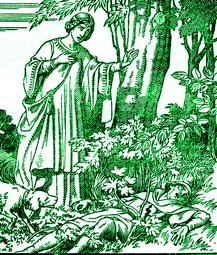Lives of the Saints
Our Models and Protectors
Spiritual Bouquet:
February 22

Saint Margaret of Cortona
Franciscan tertiary, penitent
(1247-1297)
It is not strange that the world feels drawn to the Augustines and Magdalenes of every age. The world knows its guilt and is ashamed. With the lives of such saints placed warmly and tactfully before us, it is impossible to abandon hope. From the tumbleweed of sin many saints have grown.
Margaret was born at Laviano, in Tuscany, Italy, about 1247, of poor farm people. Her mother died when she was only seven years old, and two years later her father married again. His new wife was a strong, masterful woman, who had little sympathy for her pleasure-loving stepdaughter. Margaret had always yearned for love and it was always denied her at home. It is not hard to understand, then, how the pretty young girl fell prey to the prospect of love and luxury offered her by a rich young cavalier (whose name she never divulged) from a neighboring village. She went away with him one night and lived with him as his mistress for the next nine years, during which time she gave birth to a son. During all those years Margaret remained faithful to her lover, even though she was an object of scorn to the townspeople, who regarded her as a depraved woman.
The sudden and brutal murder of her lover brought Margaret to the realization of God's grace. Ashamed and horrified by her own behavior, she went immediately to her father's house to beg forgiveness. Although he was willing to accept her, her stepmother for a second time turned Margaret away from the love she needed so badly.
She had heard of the Friars Minor (Franciscans) and of their reputation for gentleness and patience with sinners. By this time, utterly depressed, she traveled to Cortona, where she begged admittance into the Third Order as a penitent. For the first three years of her conversion she was guided in the spiritual life by Fra Giunta Bevegnati, her confessor. It is to him we are indebted for the story of her life.
Margaret began to earn her living by nursing the ladies of the city, but soon gave it up in order to devote herself to caring for the sick poor, depending on alms for her existence. She persuaded the leading citizen of Cortona to aid her in starting the hospital of Our Lady of Mercy, staffed by Franciscans tertiaries whom Margaret formed into a congregation called Poverelle. She also founded the Confraternity of Our Lady of Mercy, which was pledged to support the hospital and to search out and assist the poor. Her son was sent to school at Arezzo, and he later became a Franciscan friar.
As Margaret continued to advance in holiness, Christ became the dominating feature in her life. She was favored with visions in which Christ spoke to her and addressed her as the third light granted to the Order of my beloved Francis, that is, exceeded in glory only by Saint Francis and Saint Clare. Margaret was also favored with visions of her guardian angel.
The people of Cortona had observed the holiness of Margaret's life, and they sought her payers in 1279, when Charles of Anjou, king of Sicily, threatened to invade Tuscany. After fervent prayer it was revealed to her that an armistice had been arranged and peace would follow.
Toward the latter part of her life our Lord said to her: Show now that thou art converted; cry out and call others to repentance. Margaret was obedient to the call and saw that she must lead a more active life. She carried on this new mission successfully, drawing many lapsed Catholics back to the Church, and she was called on many times to perform miraculous cures.
The day and hour of her death were revealed to her, and she died at the age of fifty in 1297. Her fame is mostly confined to Tuscany, where the people of Cortona refer to their patron as the lily of the valley.
The Catholic Press, The Lives of the Saints for every day of the year